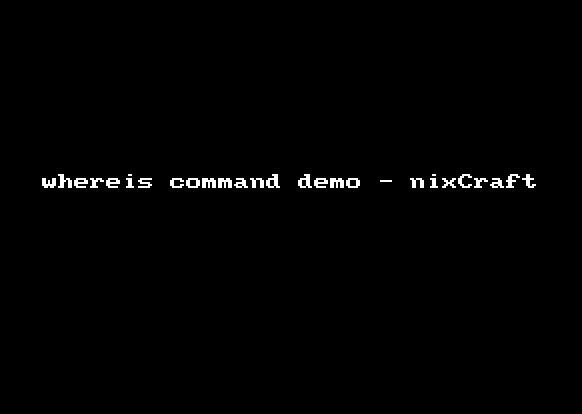
I am a new Linux and Unix-like system command line user. How do I find and locate the binary, source, and manual page files for a given command?
You need to use the whereiscommand to find the source, binary, and manuals sections for specified commands or files.
A binary is nothing but an executable from of a command such as ls or program such as Gimp. Use this command to find out:
- The location of a binary file.
- And the location of source code.
- Finally, the location of man page.
Purpose
Find the binary, source code and man page for specified program or command.
Syntax
The basic syntax is as follows:
whereis command whereis program whereis [options] program whereis -BMS directory -f command |
whereis command examples
To find out the location of the executable, source code and man page for the date command, type:$ whereis date
Sample outputs:

How do I only search for binary files?
Try passing the -b option as follows:$ whereis -b date
How do I only search for manual sections files?
Use the -m option as follows:$ whereis -m date
How do I only search for source code files?
Pass the -s option as follows:$ whereis -s date
How do I only Search for unusual entries?
A file is said to be unusual if it does not have one entry of each requested type. Thus the following example, asks for those files in the current directory which have no documentation:$ whereis -m -u *
How can I limit the searches for binaries to specific directories?
You can pass the following option to limit limit the places where whereis searches for files:
- -B /path/to/dir : Limit the places where whereis searches for binaries.
- -M /path/to/dir : Limit the places where whereis searches for manual sections.
- -S /path/to/dir : Limit the places where whereis searches for sources.
You must pass the -f option when any of the -B, -M, or -S options are used. The -f option terminate the last directory list and signals the start of file names. In this example, limit search for binary files in /bin/ directory only for ls and gcc commands:$ whereis -B /bin -f ls gcc
Sample outputs:
ls: /bin/ls /usr/share/man/man1/ls.1.gz gcc:
There is no output for the gcc command since it is located in /usr/bin/ directory. To find all of the files in the /sbin/ directory that either are not documented in the /usr/man/man8 directory or do not have source in the /root/src directory, enter:# cd /sbin
# whereis -u -M /usr/man/man8/ -S /root/src/ -f *
whereis command options
From the whereis(1) command man page:
| Option | Meaning |
|---|---|
| -f | Define search scope. |
| -b | Search only binaries. |
| -B | Define binaries lookup path. |
| -m | Search only manual paths. |
| -M | Define man lookup path. |
| -s | Search only sources path. |
| -S | Define sources lookup path. |
| -u | Search from unusual enties. |
| -V | Output version information and exit. |
| -h | Display this help and exit. |
See also
- whereis(1) Linux/Unix command man page or read it online here.
Conclusion
This page explained whereis command with examples for Linux and Unix users.


